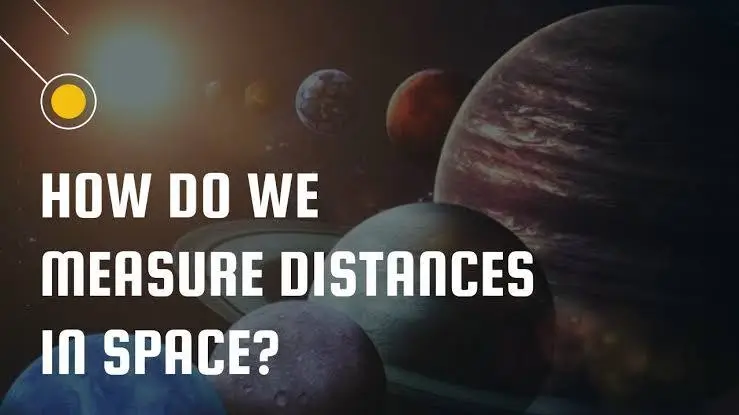How do we measure the distances to things in space?
There are a few primary methods used to measure distances to objects in space:
Parallax:
For relatively nearby objects within our own galaxy, we can use the parallax effect. This involves measuring the apparent shift in position of an object against the background as observed from two different locations (such as the Earth at different times of the year). The degree of parallax shift is inversely proportional to the distance.
Redshift:
For distant galaxies and other extragalactic objects, we can use the redshift of their light to estimate their distance. As objects move away from us, their light is shifted towards longer, redder wavelengths, and the degree of redshift is proportional to the recession velocity, which is in turn related to the distance via Hubble’s law.
Standard Candles:
Astronomers can use “standard candles” – objects of known intrinsic brightness, like certain types of stars or supernovae. By comparing the observed brightness to the known intrinsic brightness, the distance can be calculated.
Time Delay:
For extremely distant objects like quasars, astronomers can measure the time delay between the arrival of light from different parts of the object. This time delay is related to the size of the object and its distance.
Radar Ranging:
For objects within our solar system, like planets and asteroids, we can use radar to bounce radio signals off them and measure the time of flight to calculate the distance.
The choice of method depends on the type of object and how far away it is. Combining multiple techniques can provide more robust distance measurements for astronomical objects. As our observational capabilities have improved, we’ve been able to measure distances to increasingly remote parts of the universe.
हम अंतरिक्ष में चीज़ों की दूरी कैसे मापते हैं?
अंतरिक्ष में वस्तुओं की दूरी मापने के लिए कुछ प्राथमिक तरीकों का उपयोग किया जाता है:
लंबन:
अपनी आकाशगंगा के भीतर अपेक्षाकृत निकट की वस्तुओं के लिए, हम लंबन प्रभाव का उपयोग कर सकते हैं। इसमें पृष्ठभूमि के विरुद्ध किसी वस्तु की स्थिति में स्पष्ट बदलाव को मापना शामिल है जैसा कि दो अलग-अलग स्थानों (जैसे कि वर्ष के अलग-अलग समय में पृथ्वी) से देखा गया है। लंबन बदलाव की डिग्री दूरी के व्युत्क्रमानुपाती होती है।
रेडशिफ्ट:
दूर की आकाशगंगाओं और अन्य एक्सट्रागैलेक्टिक वस्तुओं के लिए, हम उनकी दूरी का अनुमान लगाने के लिए उनके प्रकाश की रेडशिफ्ट का उपयोग कर सकते हैं। जैसे-जैसे वस्तुएं हमसे दूर जाती हैं, उनका प्रकाश लंबी, लाल तरंग दैर्ध्य की ओर स्थानांतरित हो जाता है, और रेडशिफ्ट की डिग्री मंदी के वेग के समानुपाती होती है, जो बदले में हबल के नियम के माध्यम से दूरी से संबंधित होती है।
मानक मोमबत्तियाँ:
खगोलविद “मानक मोमबत्तियाँ” का उपयोग कर सकते हैं – ज्ञात आंतरिक चमक की वस्तुएं, जैसे कुछ प्रकार के तारे या सुपरनोवा। देखी गई चमक की तुलना ज्ञात आंतरिक चमक से करके, दूरी की गणना की जा सकती है।
समय विलंब:
क्वासर जैसी अत्यंत दूर की वस्तुओं के लिए, खगोलशास्त्री वस्तु के विभिन्न भागों से प्रकाश के आगमन के बीच के समय विलंब को माप सकते हैं। इस समय की देरी वस्तु के आकार और उसकी दूरी से संबंधित है।
रडार रेंजिंग:
हमारे सौर मंडल के भीतर ग्रहों और क्षुद्रग्रहों जैसी वस्तुओं के लिए, हम रेडियो संकेतों को उछालने के लिए रडार का उपयोग कर सकते हैं और दूरी की गणना करने के लिए उड़ान के समय को माप सकते हैं।
विधि का चुनाव वस्तु के प्रकार और वह कितनी दूर है, इस पर निर्भर करता है। कई तकनीकों का संयोजन खगोलीय पिंडों के लिए अधिक मजबूत दूरी माप प्रदान कर सकता है। जैसे-जैसे हमारी अवलोकन क्षमताओं में सुधार हुआ है, हम ब्रह्मांड के तेजी से सुदूर हिस्सों की दूरियां मापने में सक्षम हो गए हैं।




